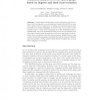IWDC
2004
Springer
14 years 5 months ago
2004
Springer
Abstract. Despite their crucial impact on the performances of p2p systems, very few is known on peers behaviors in such networks. We propose here a study of these behaviors in a ru...
IPTPS
2004
Springer
14 years 5 months ago
2004
Springer
— Mutual exclusion is one of the well-studied fundamental primitives in distributed systems. However, the emerging P2P systems bring forward several challenges that can’t be co...
IPTPS
2004
Springer
14 years 5 months ago
2004
Springer
In most of the P2P systems developed so far, all nodes play essentially the same role. In some applications, however, different machine capabilities or owner preferences may mean ...
IPTPS
2004
Springer
14 years 5 months ago
2004
Springer
In P2P systems, users often have many choices of peers from whom to download their data. Each user cares primarily about its own response time, which depends on how many other use...
IPTPS
2004
Springer
14 years 5 months ago
2004
Springer
In the hope of stimulating discussion, we present a heuristic decision tree that designers can use to judge how suitable a P2P solution might be for a particular problem. It is bas...
GI
2004
Springer
14 years 5 months ago
2004
Springer
: Since the advent of Gnutella, Peer-to-Peer (P2P) protocols have matured towards a fundamental design element for large-scale, self-organising distributed systems. Many research e...
GI
2004
Springer
14 years 5 months ago
2004
Springer
Abstract: File-sharing in mobile networks has differing demands to a P2P architecture. Resource access and mediation techniques must follow constraints given in 2.5G/3G networks. E...
EUROPAR
2004
Springer
14 years 5 months ago
2004
Springer
The interesting properties of P2P systems (high availability despite peer volatility, support for heterogeneous architectures, high scalability, etc.) make them attractive for dist...
EDBTW
2004
Springer
14 years 5 months ago
2004
Springer
Abstract. The unprecedented growth and increased importance of geographically distributed spatial data has created a strong need for efficient sharing of such data. Interestingly, ...
DEXA
2004
Springer
14 years 5 months ago
2004
Springer
Abstract. The ever-increasing popularity of peer-to-peer (P2P) systems provides a strong motivation for designing a dependable P2P system. Dependability in P2P systems can be viewe...



